|
|
|
 |
 |
 |
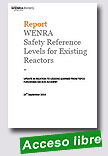 |
WENRA Safety Reference Levels for Existing Reactors - Update in Relation to Lessons Learned from TEPCO Fukushima Dai-Ichi Accident
Western European Nuclear Regulators Association (WENRA), 24th September 2014, 52 p.
A principal aim of the Western European Nuclear Regulators’ Association (WENRA) is to de-velop a harmonized approach to nuclear safety within the member countries. One of the first major achievements to this end was the publication in 2006 of a set of safety reference levels (RLs) for operating nuclear power plants (NPPs).
|
The RLs are agreed by the WENRA members. They reflect expected practices to be imple-mented in the WENRA countries. As the WENRA members have different responsibilities, the emphasis of the RLs has been on nuclear safety, primarily focussing on safety of the reactor core and spent fuel. The RLs specifically exclude nuclear security and, with a few exceptions, radiation safety.
As RLs have been established for greater harmonization within WENRA countries, the areas and issues they address were selected to cover important aspects of nuclear safety where differences in substance between WENRA countries might be expected. They do not seek to cover everything that could have an impact upon nuclear safety or to form a basis for deter-mining the overall level of nuclear safety in operating NPPs.
Given the various regulatory regimes and range of types of plants (PWR, BWR, CANDU and gas-cooled reactors) in operation in WENRA countries, the RLs do not go into legal and tech-nical details. When needed, a reference to a relevant IAEA publication is inserted.
There are significant interactions between some of the issues and hence each issue should not necessarily be considered self-standing and the RLs need to be considered as a whole set.
WENRA is committed to continuous improvement of nuclear safety. To this end WENRA is committed to regularly revising the RLs when new knowledge and experience are available. In line with this policy the initial RLs were updated in 2007 and 2008. After the TEPCO Fukushi-ma Dai-ichi nuclear accident, they have been further updated to take into account the lessons learned, including the insight from the EU stress tests. As a result a new issue on natural haz-ards was developed and significant changes made to several existing issues.
By issuing the revised RLs WENRA aims at further convergence of national requirements and safety improvements at NPPs in WENRA member countries, as necessary.
Stakeholders were asked for comments on the revised Reference Levels. All the comments were reviewed during the finalization process.
For further information, several documents on the WENRA website describe the basis used and processes followed to develop and update these RLs. Guidance on specific issues is also available on the WENRA website www.wenra.org.
For the explanation of the current update the accompanying report “Updating WENRA Refer-ence Levels for existing reactors in the light of TEPCO Fukushima Dai-ichi accident lessons learned“ was written and can also be downloaded from the WENRA website.
Extraído de: http://www.wenra.org/media/filer_public/2014/09/19/
wenra_safety_reference_level_for_existing_reactors_september_2014.pdf
|
 |
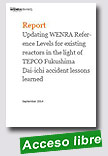 |
Updating WENRA Reference Levels for existing reactors in the light of TEPCO Fukushima Dai-ichi accident lessons learned Western European Nuclear Regulators Association (WENRA), September 2014, 15 p.
As requested by WENRA, its Reactor Harmonisation Working Group (RHWG) reviewed the 2008 version of the WENRA Reference Levels (RLs) for existing reactors in the light of TEPCO Fukushima Dai-ichi accident lessons learned. This review covered the whole set of RLs, taking into consideration recommendations and suggestions published by ENSREG as a result of the complementary safety assessments performed
|
in Europe following the TEPCO Fukushima Dai-ichi accident as well as IAEA safety requirements being under updating for the same reason and the conclusions of the 2nd Extraordinary Meeting of the Contracting Parties to the Con-vention on Nuclear Safety. WENRA made the updated reference levels available for stake-holder consultation, prior to their finalization.
As a result of the RHWG review and stakeholder input: For about half of the issues, there have been either no or only very limited changes; The issues where there have been the most significant changes are: - issue A (Safety Policy); - issue C (Management System) RLs relevant to safety culture have been introduced; - issue E (Design Basis Envelope for Existing Reactors); - issue F (Design Extension of Existing Reactors) Design extension conditions have in particular been introduced for consistency with IAEA SSR-2/1 safety standard, as well as the need for independent and diverse heat removal means, one being effec-tive for natural hazards exceeding the design basis; - issue LM (Emergency Operating Procedures and Severe Accident Management Guidelines); - issue N (Contents and Updating of Safety Analysis Report);
- issue O (Probabilistic Safety Analysis); - issue P (Periodic Safety Review);
- issue R (On-site Emergency Preparedness); A new issue (Issue T) dedicated to natural hazards, has been established. This issue has a strong interface with issues E and F.
In many cases, changes have been introduced to explicitly take into account spent fuel stor-age, sites with multiple reactors, actual conditions at the site resulting from an accident (in-cluding those which may be caused by a natural hazard), conditions more severe than the ones considered in the design basis of the plant or the need to ensure relevant equipment or facilities will remain unaffected so that foreseen actions to respond to an accident can be implemented.
RHWG also provides guidance documents on issues E/F and on issue T.
Extraído de: http://www.wenra.org/media/filer_public/2014/09/19/rhwg_report_on_updated_
rls_-_september_2014.pdf |
 |
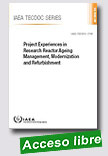 |
Project Experiences in Research Reactor Ageing Management, Modernization and Refurbishment
IAEA TECDOC, 2014, 208 p.
With the majority of research reactors having more than 40 years of operating experience, maintenance, modernization and refurbishment is increasingly more important for safe and viable operation. On the other hand, the consequences of operating conditions upon reactor structures, systems and components (SSCs) have been observed and studied, resulting in numerous techniques and regimes for controlling and mitigating the negative effects. These efforts can be |
subsumed under the premise of ageing management, an engineering, operation, and maintenance strategy and corresponding actions to control within acceptable limits the ageing degradation of SSCs [1]. Although ageing management is vital to safe operation at all stages of a research reactor’s lifetime, operating organizations have formulated various methods and tools to implement programmes in line with a graded approach dependent on operational conditions, equipment specifications and regulatory guidelines. The design and best practices in the management of SSC ageing provide insight into establishing an effective programme to improve research reactor reliability and safety.
Research reactor operating organizations now possess immense information and experience on the design and implementation of ageing management programmes. For the large number of relatively aged reactors, ageing management has risen from routine inspection, corrective maintenance and system overhaul, resulting in thorough analyses of SSC degradation under natural wear and reactor level conditions of temperature, pressure and radiation. Through the provision of technical guidance as well as networking and cooperation among organizations
within the international research reactor community, strategies for managing similar systems and components and tools for monitoring degradation and auditing programmes can be made available. Such information has spurred a recent trend of incorporating ageing management programmes into the design and construction of new research reactors, as reported for newly operating and planned reactors in Argentina, China, India, Morocco, Ukraine and Vietnam.
Extraído de: http://www-pub.iaea.org/MTCD/Publications/PDF/TE-1748_web.pdf |
 |
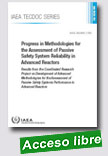 |
The overall objective was to achieve progress in the development of a common technology - neutral approach to the substantiation and evaluation of the reliability of passive safety systems, which would enable the application of risk-informed approaches to design optimization and safety qualification of advanced nuclear power plants (NPPs), contributing to their enhanced safety level and improved economics.
|
The specific research objectives of this coordinated research project (CRP) were: To identify the scope of application and common requirements for a technology-neutral methodology for reliability assessment of passive systems for advanced NPPs; To work out a consensus set of definitions relevant to reliability assessment of the passive systems and their treatment by PSA; To identify a set of common benchmark problems to compare and validate methodologies for reliability assessment of passive systems, including such issues as
systematic failure modes and effects analysis (FMEA), component failure rates, treatment of dependencies in fault tree (FT) models, impact from internal and external hazards, etc.; To perform trial applications of various approaches to reliability assessment of selected benchmark problems, with evaluation of uncertainties; To perform comparative analysis of the results and work out suggestions for a common analysis-and-test based approach; To identify necessary R&D, e.g. related to further development and validation of best estimate and computational fluid dynamics codes for passive system performance analysis against experimental benchmarks for natural and mixed convection.
Extraído de: http://www-pub.iaea.org/MTCD/Publications/PDF/TE-1752_web.pdf
|
 |
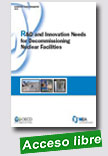 |
R&D and Innovation Needs for Decommissioning Nuclear Facilities
Nuclear Energy Agency (NEA), 21/07/14, 314 p.
Nuclear decommissioning activities can greatly benefit from research and development (R&D) projects. This report examines applicable emergent technologies, current research efforts and innovation needs to build a base of knowledge regarding the status of decommissioning technology and R&D. This base knowledge can be used to obtain consensus
|
on future R&D that is worth funding. It can also assist in deciding how to collaborate and optimise the limited pool of financial resources available among NEA member countries for nuclear decommissioning R&D.
Extraído de: http://www.oecd-nea.org |
 |
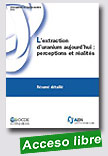
|
Perceptions and Realities in Modern Uranium Mining – Extended Summary
Nuclear Energy Agency (NEA), 14/08/14, 19 p.
Producing uranium in a safe and environmentally responsible manner is not only important to the producers and consumers of the product, but also to society at large. Given expectations of growth in nuclear generating capacity and associated uranium demand in the coming decades – particularly in the developing world – enhancing awareness of leading practice in uranium mining is important. This extended summary of the
|
report Managing Environmental and Health Impacts of Uranium Mining provides a brief outline of the driving forces behind the significant evolution of uranium mining practices from the time that uranium was first mined for military purposes until today.
Extraído de: http://www.oecd-nea.or
|
 |
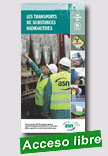 |
Le Transport de Substances Radioactives (Fiche d'information du public n°8)
L’Autorité de Sûreté Nucléaire, 24/07/2014, 4 p.
Chaque année, environ 800 000 transports de substances radioactives sont organisés en France. L’Autorité de sûreté nucléaire (ASN) est responsable du contrôle de la sûreté de ces transports.
|
Extraído de: http://www.asn.fr/content/download/87733/613087/
version/1/file/Fiche+d%27information+du+public+n%
C2%B08+-+le+transport+de+substances+radioactives.pdf
|
 |
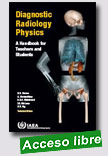 |
Diagnostic Radiology Physics: A Handbook for Teachers and Students
IAEA Non-serial Publications, 2014, 682 p.
This publication is aimed at students and teachers involved in programmes that train medical physicists for work in diagnostic radiology. It provides, in the form of a syllabus, a comprehensive overview of the basic medical physics knowledge required for the practice of modern diagnostic radiology. This makes it particularly useful for graduate students and residents in medical physics programmes. The |
material presented in the publication has been endorsed by the major international organizations and is the foundation for academic and clinical courses in both diagnostic radiology physics and in emerging areas such as imaging in radiotherapy.
Extraído de:
http://www-pub.iaea.org/books/IAEABooks/8841/Diagnostic-Radiology-Physics-A-Handbook-for-Teachers-and-Students
|
 |
|

|
Continuing Professional Development (CPD) Scheme, Third Edition
The Royal College of Radiologists, July 2014, 27 p.
The General Medical Council (GMC) defines continuing professional development (CPD) for doctors "any learning outside of undergraduated education or postgraduate training that helps you maintain and improve your performance. It covers the development of your knowledge, skills, attitudes and behaviours across all areas of your professional practice. |
It includes both formal and informal learning actvities."
This publication sets out The Royal College of Radiologists (RCR) CPD scheme for doctors who have completed their specialist training, and who are working in clinical oncology and clinical radiology.
Extraído de: http://www.rcr.ac.uk/docs/about/pdf/RCR(14)3_CPD_Third.pdf
|
 |
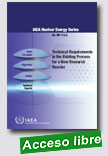 |
Technical Requirements in the Bidding Process for a New Research Reactor
IAEA Nuclear Energy Series, 2014, 42 p.
Interest in developing research reactor programmes has grown significantly in recent years. Currently, a significant number of Member States are in different stages of new research reactor projects. The majority of them are building their first research reactor as as a key national installation for the development of their nuclear science and technology programmes. In this context, this publication has been
|
developed to assist Member States in the preparation of the technical requirements for the bidding process of a new research reactor. The publication addresses the preparation phase of the bidding process and discusses criteria that may be used in the evaluation of the bids. The guidance applies to all reactor types and technologies and it does not recommend a specific reactor type or technology or a specific design. However, it is assumed that the publication will be used by a Member State that has made a commitment to build a safe, sustainable, robust design and easy maintainable research reactor. The guidance provided in the publication is primarily oriented to Member States building their first research reactor; however, such guidance could also be useful for the bidding process of subsequent reactors.
Extraído de:
http://www-pub.iaea.org/books/IAEABooks/10606/Technical-Requirements-in-the-Bidding-Process-for-a-New-Research-Reactor
|
| |
| |
|
|
| |
|
|
|
| |
|
|
|
| |
|
|
|
|
|
